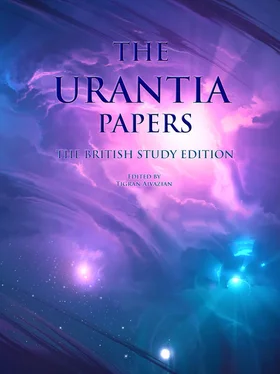Notes to Paper № 28
Significances, In 1955 text: Significance. The plural is required to agree with the verb “are,” and its construction is paralleled by the formation of the plural Discerner(s) of Spirits in a similar setting at 28:5.20 in the text. The structure of the plural as a whole is confused by the plural form of the last word in the singular of the name.
Significances, In 1955 text: Significance. Same explanation as 28:6.4 above.
Notes to Paper № 29
Centre, In 1955 text: Central. There is no other reference to Seven Central Supervisors anywhere in the text but there are multiple references to Seven Centre Supervisors (primary description at 98:4.1. in the text) who function closely with the Supreme Power Directors and can be very reasonably substituted here for the otherwise unknown Central Supervisors.
Notes to Paper № 32
Its 619 ... 2 inhabited worlds., Assuming that there are no physical systems in Satania with more than 4 inhabited planets, it is very easy to work out the numbers of systems with 1 and 3 inhabited planets — these turn out to be 511 and 4, respectively. And the total number of physical systems in Satania turns out to be 562.
Notes to Paper № 35
Gabriel and the Father Melchizedek are never away from Salvington at the same time, But they were apparently away at the same time on the Mount of Transfiguration, cf. 158:1.6-8. Either here or in Paper 158 we seem to have an example of deliberate textual corruption by Caligastia's agents in order to introduce contradiction and discredit this great Revelation.
Notes to Paper № 36
anything, In 1955 text: any thing. The compound word is the correct choice in this case. The sentence simply does not read well if, to test an alternative hypothesis, the assumption is made that the two-word format was chosen by the author for emphasis (which, to this editor, is the only discernible rationale for the two-word form).
dematerialization ... forever deprives them of reproductive prerogatives, Is this also true of normal human mortals? If so, then it would appear that the experiences of Betty Andreasson cannot be explained as a journey in the transport seraphim. Rather, they were more likely to be the projections of the Thought Adjuster of this highly spiritually developed person, permeated by love and unselfish service. The evidence for Betty being enseraphimed is based solely on her perception of immersion in the white liquid-like cloudy substance during the trip, which also formed a part of my own very similar experiences. However, we know too little about the mechanism of the detachment of Thought Adjuster from the body to conclude that “passing through the white cloud” (as was witnessed by several other prophets, both ancient and modern) is necessarily an indication of being transport-enseraphimed. For more information I highly recommend the series of five books by Raymond E. Fowler which document the prophetic mission of Betty Andreasson and her numerous contacts with the seraphic Planetary Government in great detail, namely: 1. The Andreasson Affair , 2. The Andreasson Affair: Phase Two , 3. The Watchers , 4. The Watchers II , 5. The Andreasson Legacy .
Notes to Paper № 37
tertiary, In 1955 text: secondary. While both a secondary and a tertiary Circuit Supervisor are assigned to the supervision of a single local universe’s circuits, only the tertiary Circuit Supervisor is stationed within the local universe — the secondary Circuit Supervisor is located on the superuniverse headquarters (See 24:1.5-7 in the text). Therefore, if Andovontia is “stationed in our local universe” he would be a tertiary Universe Circuit Supervisor. A straightforward explanation for the origin of the error relies on the inferred use of the somewhat unusual but nonetheless valid abbreviations 1ry, 2ry, and 3ry in the manuscript. These abbreviations are common within several disciplines (e.g., grammar/phonetics, medicine, chemistry) and when used in close proximity to each other their meanings are clear even to the general reader, but this instance is not located near similar references, so the likelihood of its use here remains only a probability based on typographical observation, rather than a certainty. This explanation, however, makes an impossible typographical error into common one — a mis-typed character.
Notes to Paper № 41
2·10 30kg, Note that the current scientific estimate of Sun's mass is 1.98892·10 30kg.
40,000 times, In 1955 text: sixty thousandtimes. Textual consistency and current scientific estimates of our sun’s density both support the change to “40,000.” The first paragraph of this section states that our sun is about 1.5 times the density of water 1 g/cm 3, and 40,000 times this is 40 kg/cm 3; the current scientific estimate of the sun’s density is 1.4 times the density of water; 40,000 times that is 56 kg/cm 3. The likely cause of this error in the 1955 text is that the number in question was written as a numeral in the manuscript (40,000 not forty thousand), and the error was caused by a simple keystroke error in which 6 was mis-keyed for 4, creating 60,000 instead of 40,000. When the text was formatted for printing, the numerals were changed to words, and an error that formerly consisted of one digit was transformed into an incorrect word. The formatting of words and numbers for printing is not a revelatory issue; it is a matter of style, and is covered extensively in the Chicago Manual of Style . (The problem at 43:1.6 in the text appears to have had an identical origin, and 42:5.1 in the text is very closely related.)
Notes to Paper № 42
γ-rays, In 1955 text: Y rays. From external reference to physics, and multiple internal cross-references (see for example 42:5.7), gamma is clearly intended here. As to the origin of the “Y” in the 1955 text, it is likely that the Greek letter “γ” (gamma) was mistakenly transposed into “Y” at some point in the preparation of the original edition (probably at the time of the first typing from the original manuscript) either because of a faulty inference from the immediately preceding X, from an unfamiliarity with the Greek alphabet, or simply because there was no better way to represent the character on a standard typewriter. Even though a typesetter would have been able to place the Greek letter “γ” on the page, the later decision to replace that letter with gamma is clear, reasonable, and consistent with the usage found elsewhere throughout The Urantia Book.
more, In 1955 text: less. [For historical reference, the first discussion of the relative masses of the structural elements of atoms in the Encyclopaedia Britannica is found in its 11 thEdition (1910 / 1911) with revisions in the 12 th(1922). The calculation of the relative masses of the electron and the hydrogen atom was undergoing a rapid evolution just prior to the writing of The Urantia Book, the ratio being 1:1700 in 1897; 1:2000 in 1904; and 1:1845 by 1922. This last ratio is also the one quoted in the 1934 Websters.] The revised wording is consistent with the statement in the paragraph following the subject paragraph 42:6.8 in the text where the author states that a proton is “eighteen hundred times as heavy as an electron;” and is also in general agreement with current scientific opinion which places the ratio at about 1:1836. After the committee’s work, this item, plus the closely-related following item, are the only recommended changes that do not have a straightforward typographical explanation.
Читать дальше






![Theresa Cheung - The Dream Dictionary from A to Z [Revised edition] - The Ultimate A–Z to Interpret the Secrets of Your Dreams](/books/692092/theresa-cheung-the-dream-dictionary-from-a-to-z-r-thumb.webp)





